Little things stand prominent in the memories of Tom and Carol Wingo.
Retired teachers and former “snowbirds” – people who temporarily relocate to warmer areas to escape winter’s bite, they permanently switched Montana for southern Arizona in 2019. Now, they dedicate much of their time to providing relief to immigrants who make it through a section of the border wall between Mexico and the US.
“Sometimes you see that people have put on make-up; getting ready for their new life,” says Carol, during a visit to a section of the wall south of a town named Why.
“We found a teapot with leaves inside. They had a little celebration after making it this far.”
READ MORE
Tom remembers the kindness of two men who started their journey in North Africa and offered him a bottle of Gatorade after they crossed on a scorching hot day. “I told them, ‘Thanks, but I don’t like Gatorade.’”
Through Samaritans Without Borders, the Wingos help to maintain a series of water-dispensing stations, given hydration is essential for those exposed to the desert’s scalding heat, and a shelter in Sonoyta on the Mexican side of the wall for those thinking about crossing or sent back out.
Tom at one point found a rock on top of one of the water dispensers with 6,000 Japanese yen underneath. “I thought we were going to be rich. But it’s only about $30. A tip.”
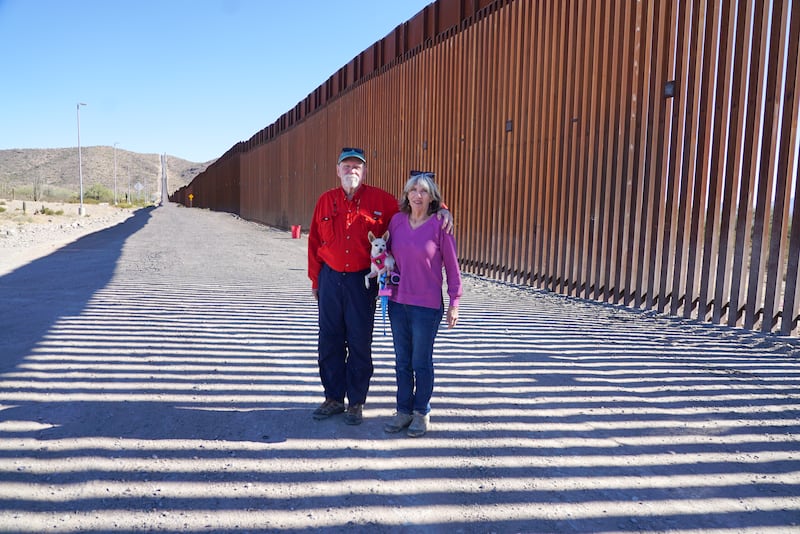
Donations, of whatever size, are the bedrock of the non-profit operation.
“Tom’s childhood friend, his aunt wrote To Kill a Mockingbird,” Carol says.
“I remember there was this real fascinating lady, but I had no idea she was going to write a book,” Tom continues. “I have a first edition signed copy. She’d dead now but because she never married, she left [the friend] a crapload of money.”
“So, Harper Lee’s trust fund helps us out. It’s kind of cool,” Carol adds.
***
Immigration and border security have been key issues in the US presidential election campaign. For Republicans, immigration is the second most important topic after the economy, and their candidate Donald Trump claims an “invasion” has been allowed to happen on the watch of the Democrats and Kamala Harris, whom he refers to as the “border tsar”.
[ Donald Trump’s deportation agenda overlooks immigration’s role in US successOpens in new window ]
Trump has labelled those illegally entering through the southern border, which stretches for more than 3,100km between California and Texas, as violent criminals, prison escapees, drug traffickers and a drain on America. He has promised to “seal the border” and oversee mass deportations if returned to the White House. The total number of undocumented immigrants in the US was estimated in 2022 at about 11 million, including a five-figure number of Irish people.
US Customs and Border Protection data counts people who attempted to enter illegally and those who tried to enter legally but were deemed inadmissible. There were about 2.4 million such “encounters” both last year and in 2022 at the southern frontier, and more than eight million during Joe Biden’s presidency. During Trump’s term, from 2017 to 2020, there were about 2.4 million such encounters.
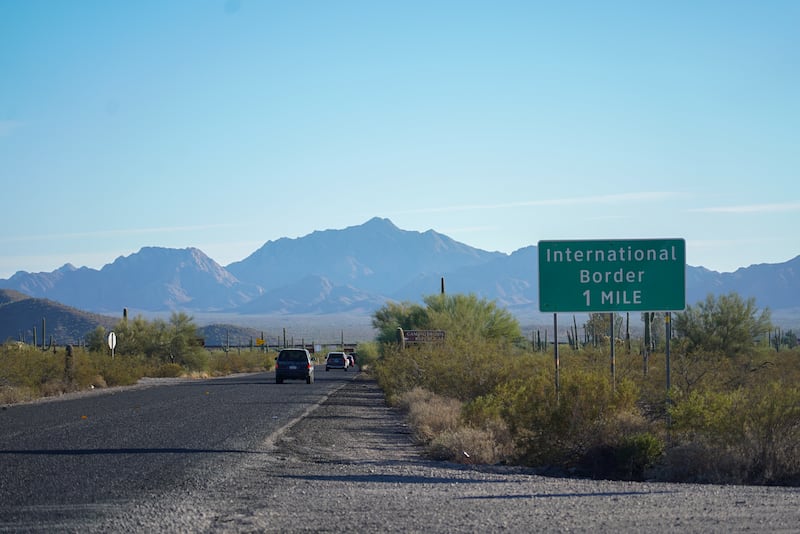
Attempted crossings plummeted during the Covid-19 pandemic, with the high numbers in 2022 and last year seen as pent-up demand working its way through. The rise is also attributed to the increase in people attempting to escape war, poverty, political repression, climate disaster and gang crime, with a share seeking to enter the US.
The numbers have slowed in the second half of this year after Biden implemented an executive order that restricts asylum claims from those crossing the southern border once a daily limit has been exceeded for a period of a week. He made the move after Republicans blocked a bipartisan immigration bill aimed at reforming the wider system.
***
In Organ Pipe Cactus National Park in the Sonoran Desert, cacti grow alongside hardy species like mesquite and creosote bushes. It feels like being in the wilderness until a giant steel wall comes into view and you see related dumpsters, portable toilets, floodlights and security cameras.
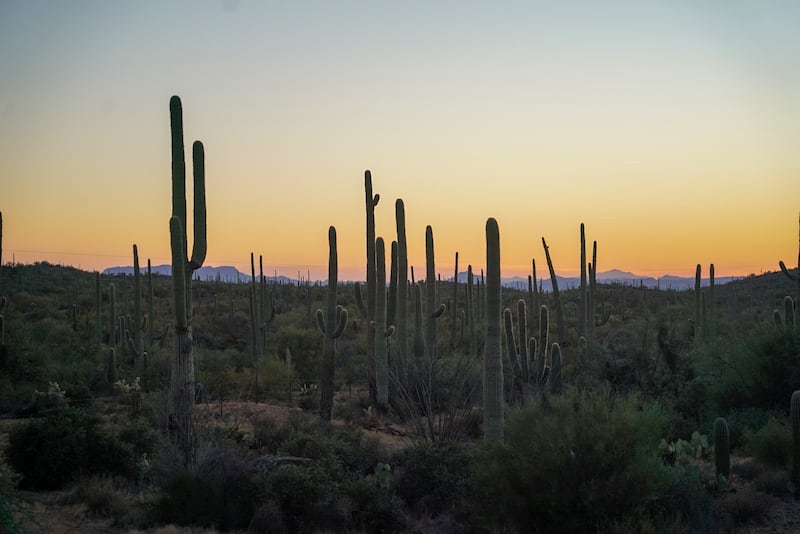
Most of those who make it here through the wall succeed only after providing payment to a Mexican cartel, dollar estimates of which vary from hundreds into the thousands. “The more you pay the cartel, the less you walk,” Tom says.
A highway runs along the Mexican side and people are bussed up to sections of the wall where cartel members use power tools to cut holes and then usher them through.
Recalling the peak of the migrant arrivals last year, Tom says: “We could come here and ride six miles down to our last water station and see nobody.
“Then we’d turn around and come back and there could be 300 people walking down the road (on the American side). The cartel would cut a hole that quick ... If they don’t cut a hole, some guys will use rope ladders.”
He points out dozens of spots where breaches have been welded on the US side, with dates scrawled in white chalk alongside the repaired patches.
Many people who cross want to be stopped by US Border Patrol so they can make an asylum claim. The Wingos mention meeting people seeking refuge from China, India, Afghanistan, Sudan, Mauritania, Ukraine, Venezuela and elsewhere.
Others, including some whose asylum applications were rejected, seek to evade detection and take off into the desert on long and dangerous journeys away from border posts.
Humane Borders, which started in Tuscon in 2000 with the aim of making the desert safer for immigrants attempting to traverse it, has to take some grim statistics into account when planning its operations.
It looks at coroners’ reports from near the border and for evidence of traffic – discarded water bottles, toiletries and clothing – when plotting where to locate its water stations.
“In the 25 years Humane Borders has been operating in southern Arizona, sadly 4,300 migrants – men, women and kids – have died right in Tuscon’s backyard,” says Laurie Cantillo, chair of the non-profit organisation’s board. “That’s not acceptable.”
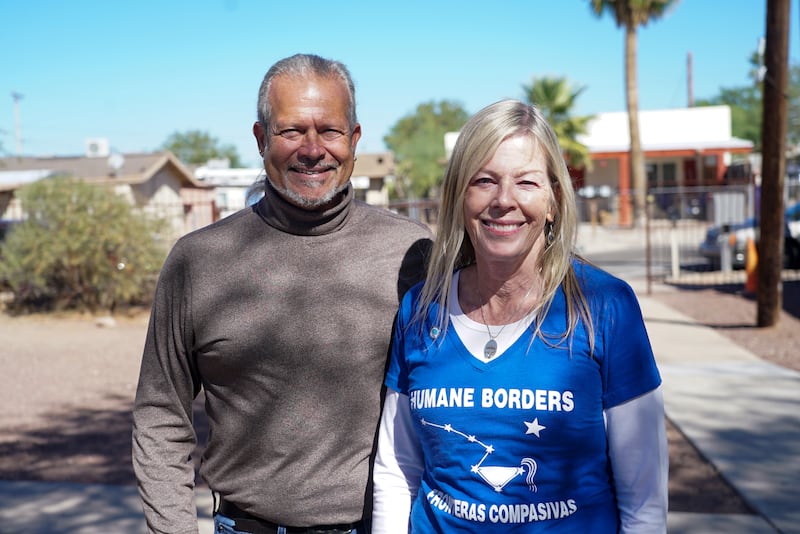
This year, Cantillo says, the Pima County medical examiner has reported 115 immigrant deaths, but “sadly there are many more, people go missing and are never found”. Fatalities tend to be a result of exhaustion, dehydration, falls and people getting lost. Some of the bodies are never identified.
Cantillo says Humane Borders occasionally finds its water stations have been vandalised – pierced, drained and even shot at – by vigilantes who feel the group’s work encourages illegal immigration.
“I don’t understand how people do that,” says the group’s treasurer David Kugler-Sarando, “but constant messages of ‘fear, fear, fear’ and ‘hate, hate, hate’, it drives people to do these things.
“[The vigilantes] walk around there dressed like a paramilitary force, with assault rifles and camo and Kevlar vests, acting like a military ... [Immigrants] don’t know these guys are not military … it must be very frightening for them.”
“The border was once a friendly place,” Cantillo says. “Families lived on both sides. I remember a time when I could walk across into Nogales, go shopping for the day and walk back, and there were no walls to destroy our environment.”
Some of Trump’s campaigning rhetoric on illegal immigrants, many of whom are from Central and South America, has been roundly criticised. “The Democrats say, ‘Please don’t call them animals. They’re humans.’ I said, ‘No, they’re not humans, they’re animals,’” he told a rally in Michigan. He has also repeated a baseless claim that Haitian refugees in Springfield, Ohio were eating dogs and cats.
Nevertheless, Trump’s standing with Latino voters has apparently improved since 2020, with a recent Reuters/Ipsos poll showing him trailing Harris by just 2 percentage points among men, compared to a 19-point deficit against Biden four years ago.
Mike Madrid, a political strategist and author of The Latino Century, says Latino voters could have an outsize impact on this election as, for the first time, they will make up “more than the margin of victory in every one of the battleground states”.
He says “generational differences” have a bearing on perspectives and third and fourth generation Latinos “do not believe [Trump] is talking about them” when making comments regarded as demonising immigrants.

“If he had been saying this 20 years ago, he would be getting crushed. But the explosion of later generation Latinos is really redefining the way non-white minorities are responding to these issues.”
Madrid says Latinos are “decidedly more pro border security than they ever were”, noting polling which show more than 40 per cent support extending the border wall.
“That’s why Kamala Harris has gone so far to the right on this issue. There are more Latino voters to be had on border security than on immigration reform. That is a remarkable change in American politics.”
Harris has said the American “immigration system is broken and needs comprehensive reform that includes strong border security and an earned pathway to citizenship”. She has outlined a plan to crack down on asylum claims and extend the curbs put in place earlier this year by Biden.
***
Cantillo says the rhetoric from Democrats and Republicans on immigration is very different, but their policies are not that far apart nowadays. She says the numbers crossing the border illegally have dropped to a fraction of what they were since Biden enacted his order and are now “manageable”.
Tom Wingo agrees. “We probably have about 60-80 a day now, but they usually come through at night and we don’t see them.
“We think with the election coming, the US is putting a lot of pressure on Mexico to slow things down. To make it look better. That’s the way politics works.”
Soon afterwards, a group can be seen walking in their direction having come through a breach in the wall. Tom says this is the first time he has seen people entering in “three or four months”.
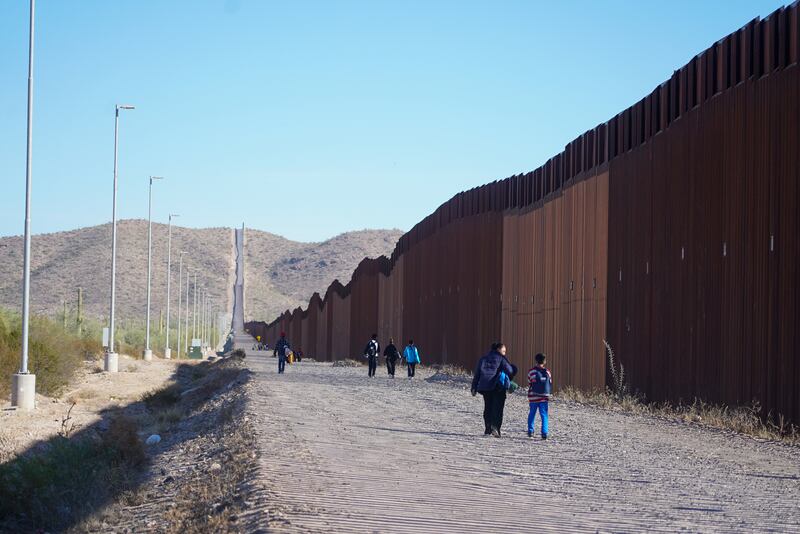
The Wingos load up on granola bars and bottles of water and signal in their direction. “Agua, agua,” Carol says.
First, it’s a group of six, followed by a couple who say they are from India and began their journey two months ago, and then another group of six including a woman and her son. “These guys are fresh off the bus and they probably don’t need anything,” Tom says. “The Border Patrol will know they’re here, so they should be processed quickly and on their way.”
The woman says she and her 11-year-old boy began their journey near Guadalajara, Mexico, a 21-hour drive from the border. They have walked about 2km from where they entered the US.
She says their home state, Jalisco, has been “taken hostage” by narcos. She works cleaning car windscreens but “the cartel demands money from me”.
“I don’t like this life for him,” she says of her son, adding that she also has three adult children.
“I want to go to Chicago,” she says, adding that she has family there.
The border crossing cost them 10,000 pesos (€453), and while she feels “much” hope having entered the US, there is also fear about what happens next.
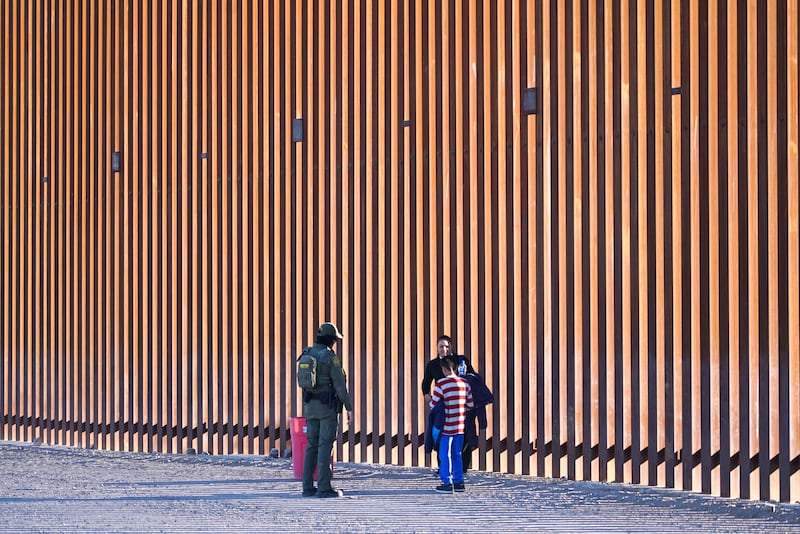
As Border Patrol agents approach, the boy passes his plastic bag of Cheetos and other snacks through the wall to a man on the Mexican side who is pleading for food.
One agent speaks to the mother and son while his colleague drives after the other 12 people who crossed with them as they have kept walking up a steep hill. The agent thoroughly checks the mother and son, and their bags, for contraband, and then has them sit up against the wall to await their fate.
What are their chances?
“If she’s got proof of the danger that she’s in,” Carol says, “if family members have been murdered, and she has documentation, then she may have a case. It depends on the numbers of people coming through, the agent and whether they let her ask for asylum. It’s a crapshoot.”
“These people may get immediately put back across the border,” Tom says. “If she paid the cartel, she might have two more tries. But if she is fingerprinted, they would know if she tried again and that would damage her claim.”
- Sign up for push alerts and have the best news, analysis and comment delivered directly to your phone
- Find The Irish Times on WhatsApp and stay up to date
- Our In The News podcast is now published daily – Find the latest episode here




















